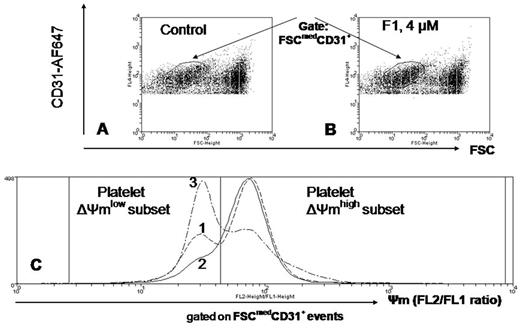Abstract
The mitochondrial membrane potential (ΔΨm) drives many functions including cellular energetics and signaling being a major determinant and indicator of cell fate. Mitochondria are considered as promising therapeutic targets because they are involved as either a cause or consequence of many chronic diseases. Previously, we reported on two novel water-soluble polyol-methanofullerenes С60[С9H10O4((OH)4]6 and С60[C13H18O4((OH)4]6 that concentraion-dependently dissipate ΔΨm in Yarrowia lipolytica yeast cells (Kalacheva et al., 2015). This observation justifies further studies of those fullerene derivatives as mitochondria-targeted biological response modifiers. Here, we proceed by exploring methanofullerenols-driven individual mitochondrial responses of human whole blood platelets, lymphocytes and granulocytes ex vivo .
A cytofluorimetric JC-1-based ratiometric assay was used to quantify ΔΨm in human heparinized whole blood cells using "no lyse-no wash" protocol minimizing activation artifacts caused by cell isolation. Briefly, heparinized blood (50 µl) obtained from healthy volunteers (n= 5) was incubated with JC-1 (20 µM final concentration, Biotium, Inc) and either 5 µl anti-CD45-PerCP (BD Biosciences) or 5 µl anti-CD31-Alexa Fluor 647 (BD Biosciences) in the presence of methanofullerenols С60[С9H10O4((OH)4]6 and С60[C13H18O4((OH)4]6 (4 µM and 40 µM) for 30 min at 37 C°, 5% CO2. Immediately after the end of incubation 5 µl whole blood aliquots were taken up from each sample, mixed with 1000 µl CellWash buffer (BD Biosciences) and run on a FACSCalibur cytometer with a CellQuest Pro software. CD45-negative events and CD31-negative events were excluded throughout acquisition by appropriate thresholds. The normalized mitochondrial potential ΔΨm was expressed in arbitrary units as the FL2/FL1 ratio of orange (JC-1 dimers, em 590 nm) to green (JC-1 monomers, em 529 nm) fluorescence signals calculated and plotted by the Weasel v2.2.3 analysis software.
Both methanofullerenols applied at concentrations of 4 µM and 40 µM after 2 h incubation period did not change ΔΨm, cell size and granularity of SSClowCD45high lymphocytes and SSChighCD45med granulocytes. The С60[C9H10O4((OH)4]6 methanofullerenol at concentration of 4 µM hampered by 32,5 % (P<0.01) time-dependent proapoptotic transition from CD31+ΔΨmhigh platelet subset(29,8 %) to CD31+ΔΨmlow platelet subset(20,1 %). An example representative graph is shown in Figure 1. However its more hydrophobic homologue С60[C13H18O4((OH)4]6 did not prevent platelet Ψm dissipation. We believe that different cytoprotective activity of methanofullerenols studied is attributed to diverse structure, antioxidant potential and target cell type.
Conclusively, the provided "no lyse-no wash" proof-of-principle protocol offers a tool for personalized diagnostics and bioenergetic therapy monitoring of mitochondrial dysfunctions in clinical settings. The С60[C9H10O4((OH)4]6 methanofullerenol appears to be a promising candidate for mitochondria-targeted prevention of apoptosis of banked platelet concentrates.
This study was supported by the Russian Government Program of Competitive Growth of Kazan Federal University. RAA was supported by state assignment 20.5175.2017/6.7 of the Ministry of Education and Science of Russian Federation.
Figure 1. Cytofluorimetric quantification of mitochondrial membrane potential ΔΨm in whole blood platelets. (A) Gating of intact single platelets with physiological size (FSCmedCD31+ events) to exclude platelet microparticles (FSClow), platelet-WBC and platelet-RBC conjugates (FSChigh). (B) The C60[C9H10O4((OH)4]6 methanofullerenol (F1) did not affect platelet size and CD31 expression. (C) The normalized ΔΨm expressed as FL2/FL1 ratio in : (1) control platelets, (2) C60[C9H10O4((OH)4]6-treated platelets (4 µM), (3) protonophore CCCP-treated platelets (1 mM). Note bimodal ΔΨm distributions and clear-cut differences in platelet ΔΨm low-subset size.
No relevant conflicts of interest to declare.
Author notes
Asterisk with author names denotes non-ASH members.


This feature is available to Subscribers Only
Sign In or Create an Account Close Modal